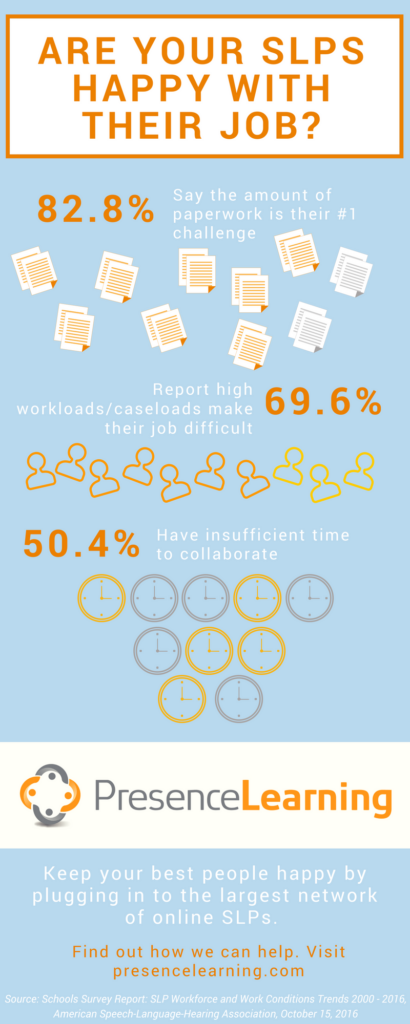
A recent CASE survey* found special education leaders lose the most sleep over personnel issues compared to other job stressors. Hiring special education teachers and related services staff can certainly be hard, especially in areas experiencing acute shortages of experienced professionals.
So how can you retain the great staff you have? The cost of rehiring and retraining can be a costly cycle, so it’s important to consider what leads people to change jobs, or even leave education altogether. According to ASHA’s Schools Survey Report: SLP Workforce and Work Conditions Trends 2000 – 2016, speech-language pathologists report three main sources of stress:
- Paperwork
- High workloads/caseloads
- Insufficient time to collaborate
This information matches PresenceLearning’s own surveys of the factors that make clinical professionals burn out of their careers. Underlying all of this is the feeling that they cannot make a difference in the lives of children when their workloads are so high.
So what can Directors of Special Education programs do to ease the strain on their staff? While there is not one magical formula, many directors have seen success by supplementing their staff with live, online therapy. This can be more cost effective than hiring an additional, expensive full time resource. An online partnership can also help lessen the most common challenges for onsite, staff SLPs; by simply lessening workloads and associated case management, district SLPs’ paperwork demands decrease, and time to collaborate increases.
There is more to an online partnership, however. By distributing workloads to online providers strategically, even more time can be saved. For example, in districts that cover a vast geographic area, travel times can be decreased by having an online resource serve homebound students, or ensuring that onsite SLPs work at sites that are more practical for them.
Of course, all online partnerships must begin with what is best for the students. While most students benefit from online therapy as much as onsite therapy, some students can benefit more from one modality over the other. PresenceLearning can help your staff understand those distinctions and provide recommendations based on your district’s caseload. Older students, particularly those in middle and high school, perceive less “stigma” around online therapy, and are therefore more willing to attend their sessions. And finally, some students find online therapy to be something novel after years of therapy, and this can help reignite their work as well.
If you would like to learn more, here are some suggested resources:
7 Myths About Online Speech Therapy: BUSTED! – An ebook that looks at some common misconceptions about online therapy, and how this method of delivery can help students and school staff.
Balancing Caseloads with Online Speech Therapy – How one school grew its partnership with PresenceLearning, and improved both staff morale and student progress at the same time.
HOT Questions, COOL Answers About Online Therapy – A more in-depth look at how districts can access high quality services, alleviate high caseloads, and improve transparency and efficiency.
Get a Demo – Perhaps the best way to learn more is to see it for yourself. Get in touch with us for a demo.
*Survey results published in the April 2, 2018 CASE Weekly Update newsletter.



